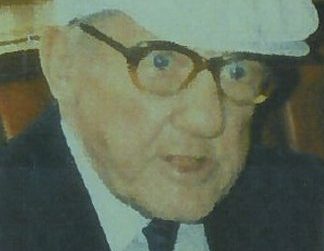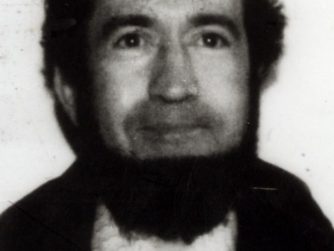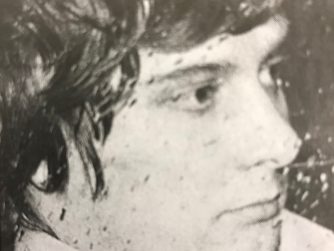“This was a frenzied attack so there must have been blood all over the house, but it’s possible not all of that blood is the victim’s, Miss Armstrong had defence wounds, which is very significant. She clearly put up a fight and it’s a possibility she caused her attacker to bleed.” – Police Officer
Number 12 Goldspink Lane in the Newcastle Upon Tyne district of Sandyford is a large property, once known as Doncaster House, today sadly one that looks quite run down and in decent need of some much-needed TLC. It’s an old building and the lane looks a nice enough place to live, and I don’t know whether it is occupied right now, but I do know that over the years it has had many occupants. The occupant for many years, right up to the early years of the 1960’s, Lillian Armstrong, was a retired school headmistress.
Until Halloween night 1963 – when Lillian was brutally murdered in her home in a crime that sparked the biggest murder hunt that Tyneside had seen for many years.

70-year-old Katherine Lillian Armstrong, known by her middle name, was your classic school marm – she had been retired since 1957, and had for many years before that been the headmistress of Denton Road Junior School. She was known as a spinster, having never married and had lived alone for all her life in Doncaster House, what was in 1963 the corner property of the lane and the current number 12. She was a very proud, very independent woman as seemed to be the standard for that generation, and after her retirement from schooling, her life seemed to revolve around the Central Methodist Church, on Newcastle’s Northumberland Road, where as a devout Methodist she had been a part of the congregation for more than 40 years, and had been an active part of the choir for the same length of time. Her social life consisted of very little more than regular choir practice at 7:30pm on a Thursday night, of which she was due to attend on Halloween night, 1963.
Lillian never made it to that choir practice.
The following morning, at about 10:30, Lillian’s cousin who lived nearby, Ada Ridley, called around to Doncaster House for a routine morning visit. Knowing that Lillian was a woman of habit who was a habitual early riser, Ada became concerned when there was no answer to her repeated knocks on the front door, and that all the curtains at the property remained closed – something which Lillian would never do. Concerned that her cousin was hurt or ill, and with a general feeling that something was amiss, Ada decided to alert police.
When police arrived, uniformed officers made the decision to force their way into the property – and were confronted with a ghastly sight.
Lying in the passage of her home, near the bottom of the stairs, was the body of Lillian Armstrong. She was fully clothed, wearing a dress and carpet slippers, and had a nylon stocking tied tightly around her neck. Her face and neck were also heavily bloodstained – and it was later determined at post mortem that cause of death had not been due to strangulation, but Lillian had died from shock and blood loss due to being brutally battered and stabbed no less than 28 times about the face and neck. The scene was heavily bloodstained, and blood was found throughout the entire house. It must have been a frenzied attack, yet defence wounds on her hands suggested that Lillian had put up a struggle against her killer.

A murder enquiry was immediately launched, and police searched for a motive for the horrific killing. There was no sign of forced entry to the house and no signs of ransacking – and Lillian had not been sexually assaulted. There was no murder weapon found at the scene, no fingerprints or footprints. Police had no clear motive and no suspects, and they really didn’t know where to begin. Sensing that this was going to be a massive enquiry, all police leave was cancelled and those already on leave were recalled to assist in the investigation. A 60-strong team of detectives began the hunt for Lillian’s killer.
The search got underway for the murder weapon – thought to have been a long-bladed instrument – and all bins, drains and grates in the area were searched in an attempt to find it, with police working on the theory that the killer would have discarded it after leaving the scene. Parks, streams and gardens were searched for it, but to no avail. Meanwhile, house to house enquiries got underway, with police revealing that they planned to speak to more than 5,000 householders in the biggest house to house enquiry that Newcastle had ever seen. By November 4th, just three days after the murder, police had taken more than 200 statements, and detectives were still midway through the task of knocking on every door within a half mile radius of the murder scene. But not one person spoken to claimed to have seen or heard anything suspicious, and with still no suspects or motive, by this time Scotland Yard had been called in.
The Metropolitan Police Commissioner had sent Detective Superintendent Eric Reid from the Scotland Yard Murder Squad to oversee the investigation, and Reid was quick to utilise the press in an appeal for witnesses and information. In an interview at the time with the Newcastle Evening Chronicle, he revealed that there was no sign of forced entry to the property and that it was considered possible that Lillian knew her killer.
He revealed that police were considering the possibility that more than one person could have been involved in Lillian’s murder, and that they were considering teens as being connected, as well as studying the files of known older male criminals who had served prison sentences for crimes utilising violence against older women. The main focus of the enquiry saw detectives trying to piece together the last hours of Lillian’s life – and they had a window of about 18 hours to try to fill in. Lillian had last been seen at about 6:30pm the following evening, where two children passing the house spotted her looking out of the window. She was expected at choir practice just an hour later – but never arrived there. Was she already dead by this time?
By the end of November, 50 detectives were still searching for Lillian’s killer in an 18-hour working day – and by the time the inquest was held into Lillian’s death at the end of January 1964, police had spoken to more than 16,000 people in the area. But the investigation had still drawn a blank, and Lillian’s murder sadly remains unsolved to this day.

Lillian’s cousin, Ada Ridley, offered her own theories to the Newcastle Evening Chronicle about what had happened. She was convinced that teenagers were responsible for the brutal murder, and had killed Lillian after entering her home as part of a Halloween prank. She also expressed regret that Lillian had not moved from Doncaster House to live closer to her family, saying:
“My cousin’s home was big, dark and gloomy. It got no sun. Time and time again I told her she should leave and take a flat near me. But she was very independent and said she was not at all afraid of living alone.”
This is a tragic and shocking crime, and as I feel I have made clear in previous episodes, I hold a special contempt for those who commit crimes against the elderly. This is a church going lady who had lived through two world wars, only to have her life taken in such a horrific way in a motiveless crime. It is almost a forgotten case due to the large passage of time, and I find that quite sad really. What then, can be estimated about the crime? I must stress in no way do I offer the following as definite, it is purely hypothesis based on what we know.
Lillian hadn’t been sexually assaulted and her clothing hadn’t even been disturbed, so a sexual motive seems unlikely. I would agree with this – an offender who has sexual assault as a motive likely commits this no matter what. There were no reported signs of ransacking, and nothing had been reported as having been taken, so robbery perhaps would seem unlikely. But that is not to say that this wasn’t the motive for her killer or killers being in the house. Indeed, blood was found throughout the house so this would suggest at least a cursory search of the house was made by the killer.
Lillian was last seen alive at 6:30pm by two children passing her house, who claimed that she was looking out of the window. She didn’t make it to choir practice an hour later – so was she already dead by that time? I believe this is a very real possibility, but of course, it is not definite that she was dead by 7:30. This is an era where telephones were not commonplace and Lillian may have been feeling ill and decided not to go to choir practice – therefore, who would she call to say she wasn’t attending?
I believe the murder at least began as a prank or a burglary, and that this killing was committed by a youth, but more likely youths. The night of Lillian’s murder was Halloween, it’s dark early and there would have children and teenagers out Trick or Treating and generally up to devilment – we were all young once and I’m sure some of us have played the odd prank as a youngster. It’s a rite of passage and would have been no different back in 1963. What if some teens had knocked on the door in an attempt to scare an elderly woman as a Halloween prank, forced their way in and then killed her in the heat of a struggle when she attempted to fight back? Lillian was a strong, stern woman and had the type of character that would have been instilled in a headmistress of the time. She would have been the exact type to admonish someone, and tell them exactly what she thought of them.
Or what if Lillian had disturbed a burglar or burglars, who were taking advantage of the early darkness. Did she then challenge him or them, drawing on her years of experience as being a figure of authority – and instead of causing the perpetrator to flee, this instead angered them? But then why didn’t they just flee? The possibility has struck me that Lillian may have known or recognised her killer – perhaps ex pupils? and when she revealed that she knew them they killed her out of fear of discovery.
I believe that there is more than one killer involved her, and I believe this for as follows: Firstly, why the overkill? Why do you stab someone 28 times about the face and neck, and then strangle them? Is it just pure bloodlust – or is it more than one person acting, either through fear, peer pressure or bravado, so that each equally share the culpability? Two methods of killing suggest more than one killer to me, perhaps an experimentation. Burglars also commonly work in pairs at least. The murder weapon was never found, and I do not believe it was actually disposed of.
At the time, it was commonplace for boys and teenagers to habitually carry knives as a status symbol, so I believe the killer or killers took them away with them and kept them. I think that the killers were from the local area and either knew or knew of Lillian – no one was seen leaving the area in a blind panic or hurried rush – and on Halloween there would likely have been people out on the streets at that time, out taking children trick or treating – so whoever it was knew the area well enough to know exactly how and where to effect a quick escape and without drawing attention to themselves. They had to know that an elderly woman lived alone in that house, and that there was no likelihood of breaking in to be confronted by a 20-stone son that was built like Basingstoke. It is likely that this person or persons had come to police attention previously, possibly through offending as a youth. This is a level of violence in someone that would have been hard to control, so it is likely the killer or killers had offended before, and after Lillian’s murder. They would likely have been in police files, they were most likely even spoken to during the course of the investigation.
Had this crime occurred today, with all of the developments in forensic science, technology, and offender profiling – then the possibility of a detection would be high. And of course, if evidence from the crime scene in 1963 is still in storage, then it is possible that DNA from the killer may be obtained, if not from an exact match then through a possible familial DNA match. Due to the large passage of time, however, if Lillian’s killer or killers are still alive, they would be likely about her age by now. They may have families of their own, and may have pushed their horrific actions as far to the back of their mind as possible. Or they may be coming to the end of their own life, perhaps in a hospital or care home. Or they may of course have even died themselves by now, and managed to escape justice for Lillian’s murder. Sadly, it looks likely that unless new evidence comes to fruition, a deathbed confession perhaps in an attempt to clear someone’s conscience, we may never know. Somebody must have known who killed Lillian Armstrong, but never said. Why? Was it out of fear, or guilt?
There is a strange postscript to this story. Lillian’s house stood empty for a few years, and by 1973 new tenants had moved in after the family who had lived there before them had left hurriedly, having only lived there for a couple of months. They had left there, the new tenant said, because the house was reportedly haunted.
Mrs Joan Black, the new tenant told the Chronicle at the time:
“The family who were here before said the place had a ghost and was spooky. They had sensed a presence, and more than once had claimed to have seen a figure stood watching out of the corner of their eye, but that there was no-one there when they turned. We don’t believe it is true, although the first lodger we had was convinced there was something unusual about the place.”
“It was always at the bottom of the stairs”
Does Lillian still occupy her home, at least in some capacity?
The True Crime Enthusiast




[…] “The Newcastle “Halloween” Murder” – The True Crime Enthusiast […]
can u make another podcast on this i am doing a whole case on thia